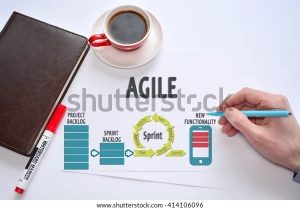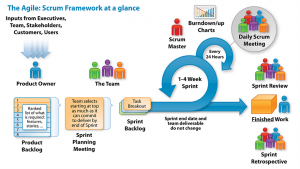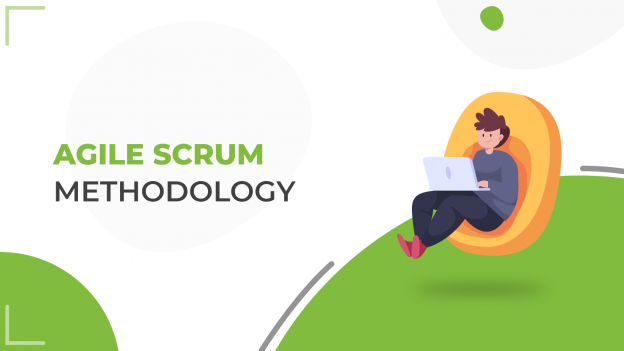What is Agile?
Agile is an approach or a way to project management and software development (web, android, etc.) that helps the whole team to deliver value to their customers to deliver a quality product in a certain time period.

Agile is a way to deliver work in small milestones instead of giving the whole at once. In Agile Requirements, plans and results are evaluated continuously so that teams can respond to change quickly.
So in short we can say that agile is a process model with iterative and incremental approaches.
Some Principles of Agile are:
- Customer satisfaction
- Early and continuous delivery
- Collaboration of businesses and developers
- Sprint-wise delivery and changes as per the requirements
Advantages of Agile are:
- Requirement changes are allowed in any stage of development or we can accommodate requirement changes in the middle of development.
- Releases will be very fast
- Customers no need to wait for a long time.
- Good communication between the team.
- It is very easy to model to adopt.
Disadvantages of Agile are:
- Less focus on design and documentation since we deliver software very faster.
- This method will not work when a client has a specified budget or schedule.
What is Scrum in Agile?
Scrum is a kind of framework through which we build software products by following Agile principles. It will help us to follow the defined principles of agile. Scrum is a type of agile methodology that consists of meetings roles and tools to use in the project to help teams working on bigger projects, collaborate and better structure and manage their workload.
It is an effective way of collaboration among teams working on complex software projects.
What Is Agile Scrum Methodology?
Agile Scrum methodology is based on sprint. In this, we manage the projects sprint-wise with the goal of delivering the highest value to customers or clients.

Agile allows teams to develop projects in small increments called “Sprints” and more effective collaborations among teams working on complex projects.
Agile scrum methodology is used by all sizes of companies for its ability to high-end solutions and efficiency to project work. Agile and scrum are two different methods to manage projects and can be used separately. However, if combined these two approaches together make the agile scrum methodology the most widespread use of agile.
How does Agile scrum work?

Agile scrum methodology is a combination of both agile and scrum frameworks. Agile means “incremental”, allowing teams to develop their projects or software in small increments. Scrum is one of the most widely used agile methodologies. You can say breaking down the large projects into small chunks called “sprints”. Agile Lets team members break down the project or we can say manage the project more efficiently by breaking it down into several stages.
Different roles in agile scrum methodology?
In core roles, there are three roles: Scrum master, product owner, and scrum team. All these people are committed to the scrum project.

Scrum Master: scrum master is the facilitator of the scrum of the project development process. The scrum master’s responsibilities are coaching and motivating the team, removing impediments to sprints, and ensuring that the team meets its goal to deliver the best product or software.
Product Owner: The product owner is responsible for prioritizing goals for each sprint, based on their value to stakeholders, such that the most important and deliverable features are built in each iteration.
Scrum Team: The scrum team is an organized group of three to nine people who have the business, design, analytical, and development skills to carry out the actual work, solve problems and produce deliverable products. Generally, it includes core team members and shared team members.
- The core team includes scrum masters, developers, and test engineers.
- The shared team includes B.A, product owner, software architect, UI/UX designer, database admin, and network admin.
Scrum Terminologies:

- User story: it represents a feature /module in the software.
- Epic: A collection of user stories is called Epic.
- Product backlog: It is a document that contains a list of all the user stories prepared by the product owner at the beginning stage of the agile process by taking all the requirements from the customer.
- Sprint/iteration: Sprint is a period of time to complete(develop and test) the user stories decided by the product owner and team, usually 2-4 weeks of time.
- Sprint planning meeting: It is a one-day meeting conducted with the team to define what can be delivered in the sprint and its duration.
- Story point: It is a rough estimation of user stories, that will be given by the developer & Q/A in the form of the Fibonacci series. During the sprint planning meeting itself, every story will be estimated by the developer & Q/a, and based upon the story points they will choose the stories and plan those stories for that particular sprint.
- Sprint backlog: It is a list of committed stories by developer/QA for the specific sprint. for each sprint, the sprint backlog will be changed.
- Scrum meeting: it is a meeting conducted by the scrum master every day for 15 minutes with the team. This is called a scrum call or stand-up meeting. Scrum master is responsible for facilitating and driving this meeting.
Here everybody should answer these questions:
- What did you do yesterday?
- What will you do today?
- Are there any impediments in your way?
And even solutions also will be discussed in this meeting for any impediments.
- Sprint retrospective meeting: this meeting is conducted after the completion of the sprint. The entire team, including the scrum master and product owner, should participate. Here they will discuss the achievements and mistakes that they have done in the previous sprint and how to improve those mistakes for the next sprint.
- Burn-down chart: it shows how much work that has been completed and the total work remaining in the sprint. it is maintained by the scrum master daily.
 End to End Technology Solutions
End to End Technology Solutions
